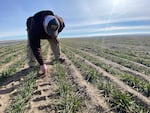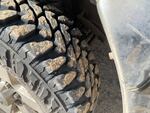
Chris Herron, 66, of north Franklin County, Wash., digs his finger down to frozen moisture in his wheat field. It’s drier than he’d like for this time of year.
Anna King / Northwest News Network
Even with all the rain and snow in California this winter, it’s been pretty dry in the Northwest, especially in much of Eastern Oregon and parts of Eastern Washington. For wheat farmers, that means there could be some nail-biting months ahead. Chris Herron owns an 8-square-mile dryland farm in north Franklin County, Washington. Correspondent Anna King spent the day with him and produced an audio postcard. The transcript below has been condensed and edited for clarity.
Chris Herron: Ready to go?
[Car door closes]
Herron: I’m a dryland wheat farmer in the less-than-12-inch-rainfall part of Eastern Washington. So you wanna look at the dry conditions in wheat country?
Anna King: Yeah, I just wanted to see what you guys are seeing out here.
Herron: The cold weather and the wind are the main issues. There's dry years, there's wet years. Sometimes the wind blows, sometimes it doesn't. It's the nature of farming without irrigation. You're depending on the rain from the sky.
Now if you look out the rear window right now — see that dust flying? It snowed last night. We had a skiff of snow. If you wanna know how dry it is — we’re driving down a gravel road and the dust is flying. It’s supposed to be wet, and winter turning to spring.
King: It’s kind of a palomino color, like a dun horse. Kind of gray, but it’s a beige-ish brown color.
Herron: That's because the soil temperature hasn't warmed up enough for any plant, whether it's a wheat plant or a weed to germinate and start the chlorophyll process to start growing.

This time of year, Herron’s tires are usually caked in mud from the wet roads. Instead, they’re dusty.
Anna King / Northwest News Network
King: These are some roads, man.
Herron: From one end of the place to the other, there’s 11 miles of private roads I have to maintain, keep gravel on, grade and spray for weeds each year.
King: You need your own public works department.
Herron: You're looking at him.
King: Now this looks a little greener.
Herron: That's because it was early seeded into great moisture. I did a good job controlling the moisture last year and was able to seed it early.
I would really prefer to have another 4 inches of snow or some rain events coming. But we could have a cool, dry spring and a hot summer. That’s what they’re forecasting.
I don’t keep track of the rain records anymore. In the old days when I was growing up, Dad used to have us go out and measure the rain gauge with the official Northwest Weather Service measuring stick, and we had the can and we’d write it on the shop wall. And that was the official record for rainfall on the ranch. Now everything’s digitized.
[Car door opens]
Herron: Here’s a mature plant that’s been desiccated by the wind. You can see some leaves dying off here due to cold stress, but as soon as it warms up, air temperature gets high — above 50-60 degrees — and the soil temperature gets up to 40, 50 degrees, it will start to green up and grow.
I can show you some places where the wind blew the knobs. It blew 'em slick, it blew all the organic matter away.
King: What is a knob?
Herron: Top of a hill, exposed to the wind. We're standing on a knob right here. It's a larger one. I mean, if you stand in a ditch, the wind doesn't blow so hard. You stand on top of your house, you better screw your hat on 'cause the wind's gonna blow it off.
Winter was dry. There's not much moisture in the air, and the spring is starting out dry. We'll know more by April, and we'll know the final answer when the wheat crop is ready for harvest in July.
Dryland farmer Chris Herron says he recently got nearly an inch of rain.